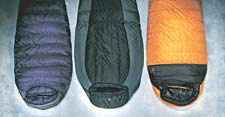If the current downward spiral in weight and compressibility continues, we won’t need sleeping-bag compartments in our packs anymore; we’ll just drop mini stuffsacks into the main well with the rest of the gear.

Two things are fueling this technological Oprah diet: First, thanks to the opening of new markets in Eastern Europe over the last five years, the availability of ultra-high-quality goose down has increased. The new supply is often superior to Asian down: European birds, it seems, are allowed to mature longer because old birds make for tastier pâté de foie gras and loftier feathers. An ounce of the best Polish or Hungarian stuff lofts to fill 750 or 800 cubic inches, as opposed to 600 or 650 c.i. for top-notch down of a decade past.
Second, mad fabric scientists striving to hatch the perfect artificial goose have refined insulations like Polarguard HV, which is 25 percent lighter than the original, and, in the case of Polarguard 3D, made from a finer, more compressible polyester filament. (A piece of Polarguard 3D pulled from a bag, incidentally, floats around the room like a feather.) Down is still tops for packability and longevity, of course, but synthetic bags are a lot less expensive and they work better in damp conditions.
We’ve collected six of the best bags for backpacking, where warmth and light weight are paramount; for mountaineering, where warmth can save your life; and for sea kayaking, where you need bags that won’t fail in high humidity. All of the bags we tested were chosen because they incorporate the latest materials and designs. As for the manufacturers’ temperature ratings, view them with skepticism, adding or subtracting ten or 15 degrees depending on what you know about your metabolism. We have, however, included some numbers that are almost as important to a night’s restÑshoulder and foot room in inches. Buy a bag too tight and you’ll wake up with your long johns in a twist. Whatever you do, don’t delay. Any one of the bags on these pages is better than that ripe mouse-nest roll you’ve been hauling.
Backpacking
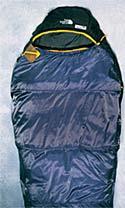
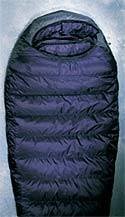
The North Face Flight (synthetic)
At a scant two pounds, one ounce, the Flight ($150) won’t unbalance a weekend backpack load, and at this price it won’t unbalance your budget either. Fifteen ounces of Polarguard Delta insulation—the lightest Polarguard to date, and exclusive to TNF until this spring—gives the Flight a 35-degree rating, sufficient for most warm-weather trips if you don’t mind wearing a hat and a heavy fleece on colder nights. The feel of the Delta insulation is more, well, downlike than any synthetic we’ve tried before: It’s soft and drapes loosely around the body, without the squirmy, clumpy feel of earlier polyesters. With 62 inches of shoulder room and 40 inches at the foot, it’s big enough for restless sleepers, who’ll also appreciate the pillow pocket in the hood.
800-447-2333;
Western Mountaineering Apache Super DL (down) Western Mountaineering offers you a choice of three lengths, several shell-material options, and extra stuffing where you need it (cold feet? no problem), and then sews it all together in California with a fussy English tailor’s attention to detail. With its 750-fill down fully fluffed, the Apache ($420) seems ready to levitate off your sleeping pad. It weighs just two pounds, six ounces, yet boasts a 15-degree rating—warm enough to shrug off an unexpected cold snap. The company doesn’t scrimp on features to attain that impressive lightweight but warm mark: The bag has a full-length zipper, a (somewhat tight) hood, and decent, if not commodious, shoulder and foot room (59 and 38 inches). The shell is Gore Dryloft, a laminated fabric that keeps condensation away from those precious feathers. Skip the Dryloft and you’ll save $135.
408-287-8944;
The Pads
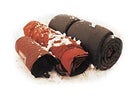
Backpacking: Cascade Designs Therm-a-Rest Ultralight 3/4 Length ($54): The Ultralight weighs just one pound (one and a half for the full-length version), 20 percent less than the original Ultralight. With open-cell foam and self-inflating air cushioning, it’s more comfortable than its 3/4-inch thickness suggests. Tall folks, however, may bang their knees on the ground all night.
800-527-1527;
Mountaineering: Mountain Hardwear Highmountain 72 Pad ($60): Mountain Hardwear uses a combination of closed- and open-cell foam in its Highmountain pad to give it an impressive insulative R value of 6.75 (compared with 2.6 for most lightweight pads). Extremely comfortable thanks to almost two inches of foam, the Highmountain is tapered at the foot to save weight. Be advised: It’s still a hefty two-pound, six-ounce package.
Sea kayaking: Big Agnes REM two-inch pad ($75): When the boat’s toting the weight, why not indulge? Big Agnes’s REM self-inflating pads are 20 by 72 inches and come in one-, 1.5-, and two-inch thicknesses. They all mate with the Cross Mountain sleeping bag, but the two-inch version feels like the finest featherbed on a gravel riverbank. At two pounds, 12 ounces, however, it’s not something you’d want to schlepp in a backpack—Big Agnes makes a thinner, mummy-shaped pad for that.
Mountaineering
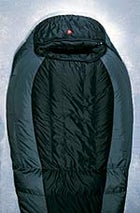
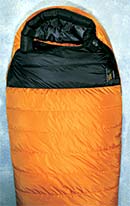
Marmot Aiguille (down) “Cold spot” is not a term Marmot’s designers tolerate. Which is why the minus-5-degree Aiguille ($520) is constructed with such complex baffling—11 in the foot, nine in the chest, six in the hood—keeping its 30 ounces of plump 800-fill down where it belongs. You might expect that all this stitching would translate to a straitjacket feel, but that’s not the case. There’s a generous 64 inches of shoulder room and 44 inches at the foot (which is lined with heavier fabric for sleeping with boots or liners on). Since wet down—even 800-fill—has the insulative value of sheet metal, the Aiguille’s shell is a Dryloft laminate to fend off dew and frost. And the weight penalty for all this performance? Just three pounds, two ounces.
888-627-6680;
Mountain Hardwear King Tut EX SL (down) The old hot-rodder’s axiom “There’s no substitute for cubic inches” holds with sleeping bags too. In the case of the King Tut ($525), 37 ounces of 775-fill down—roughly 27,000 cubic inches’ worth—keeps you steamy to a numbing minus 20 degrees. When conditions are mild (or, conversely, when they’re so nasty you’d rather get dressed inside the bag) the Tut sports a trick expandable pleat: Undo a second side zipper and the bag grows widthwise by eight inches, augmenting its already excellent 64 inches of shoulder room and 40 inches at the foot, and letting more heat escape in the process. The shell fabric is backed by a waterproof-breathable laminate. All that down and extra material adds up, of course, but four pounds, three ounces isn’t bad if it means you’ll sleep through the night.
800-330-6800;
Sea Kayaking
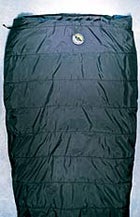
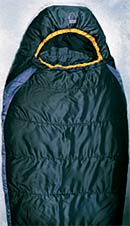
Big Agnes Cross Mountain (synthetic) If you’ve ever slid off a slick mattress pad onto the cold ground, you’ll appreciate the 40-degree Big Agnes Cross Mountain ($120). This semirectangular two-pound, three-ounce bag is insulated only on top (with 19 ounces of Polarguard 3D). The bottom of the bag is a simple envelope into which you insert any 20-inch-wide pad. Toss, turn, thrash—no matter, you stay aligned above the pad. And because there’s no insulation beneath you, the bag is less likely to soak up water. At 70 inches across the shoulder, the Cross Mountain is big enough to slip the Encampment, another Big Agnes bag, inside, giving you a multilayer all-Polarguard system good to minus 10 degrees. Complaints? The zipper only extends two-thirds the length of the bag, annoying in a summer-weight design.
877-554-8975;
Sierra Designs Metamorph (synthetic) All you need is a heavy drumbeat to accompany the striptease act of the Metamorph ($220). Zip off the top layer and the bag converts from a buxom three-pound, 11-ounce, 15-degree model to a lithe two-pound, eight-ounce, 30-degree waif. The top is no simple augmentation, though; It’s cut to wrap around the bag on three sides, integrating with the bottom layer rather than squashing it. Both shells are treated to repel moisture, so you don’t lose weather protection in either mode. No matter which configuration you’re in, you’ll notice the room inside: 63 inches at the shoulder and 43 inches at the foot. The hood (part of the bottom bag) is large and comfortable. Underneath, two straps help secure your sleeping pad against slippage.
800-635-0461;
Warm Water Survival Kit
What do you get when you head to the Yucatán with a haul bag full of the latest snorkeling and scuba gear, on a mission to cull the best of the best? These six superlative choices.
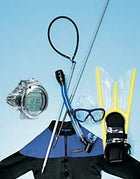
A.B. Biller Travel Spear ($94; 630-529-2729; ) Never forget the lesson of the first season of Survivor: He who spears fish, thrives. A.B. Biller’s four-piece travel spear turns any desert island into a sushi buffet, yet it breaks down small enough to fit into a backpack. Multiple tips are available, but you’ll most likely want the Paralyzer, a dagger well suited to a variety of species—provided you’ve checked local customs and regulations beforehand.
Tusa Platina Hyperdry Mask ($83; 800-482-2282; ) With its latest Platina Hyperdry, Tusa fixed a major drawback of purge-valve masks by moving the exhaust valve from the nose and tucking it in the silicone skirt below the left lens. The result: a comfortable, low-volume mask that clears easily with a gentle exhale, even when completely flooded. And because of the valve location, bubbles pass to the side, not directly in front of your field of vision.
Ocean Master Dry Snorkel ($55; 626-582-8000; ) Dry snorkels—which eliminate the need to clear water from flooded mouthpieces—have come a long way since the old ping-pong-ball-in-a-cage models. Ocean Master’s patented design means no unexpected wave or dunking can spill brine into the barrel from the top, period. For any water that sneaks in around your lips, a mouthpiece purge valve provides a quick exit. There’s one negative to the design, however: The air-filled tube pulls annoyingly at your mouth and mask strap when you dive.
Fab Force Fin SK2 ($125; 800-346-7946; ) Everywhere snorkelers congregate you see them—suckers who rented cheap fins and are paying the price in the form of blisters. Sure, SK2s are pricey, but they’re the gold standard in comfort and durability. An open-toed adjustable foot pocket makes ’em feel like slippers, not fins, and the snappy polyurethane blades have a light and zippy flipper action.
Henderson Polyolefin suit ($80; 856-825-4771; ) Even paradise has its dark side. For snorkelers in tropical waters, it manifests as tiny stinging jellyfish, nasty coral scrapes, or the searing pain of a sunburned back. Luckily, Henderson’s tropical-weight dive suit keeps those hazards at bay. Made from a 17-ounce poly/Lycra blend, it has neoprene knee-pads to protect the stretch fabric from tears, so you won’t look like a wreck even though you’re a certified beach bum.
Suunto Advanced Computer Watch ($775; 800-543-9124; ) For those infogeeks (myself included) for whom warm-water memories aren’t enough, the Suunto Computer Watch is data-rich salvation. The handsome, stainless-steel-cased watch is a fully functional dive computer, depth gauge, and bottom timer. That means it’ll chart and store every freedive you make below four feet, information which, when you get back to the office, you can download to the company PC and view with Suunto’s accompanying Dive Manager software.
Books
Wild Ideas


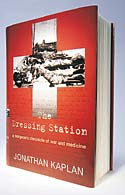
The Future of Life, by Edward O. Wilson (Knopf, $22). In volume after volume (Biophilia, The Diversity of Life, Consilience), the unrepentant father of sociobiology and Harvard’s septuagenarian ant man—”old enough,” he says, “to have had tea with Darwin’s last surviving granddaughter”—has been riding among us, the biosphere’s Paul Revere, crying out that disaster is coming. In his first book to focus exclusively on a blueprint for global conservation, E. O. Wilson defines in less than 200 pages the incalculable value and fragility of “the totality of life…a membrane of organisms…so thin it cannot be seen edgewise from a space shuttle, yet so internally complex that most species composing it remain undiscovered.” He introduces us to Emi, a Sumatran rhino at the Cincinnati Zoo, one of only a few hundred left of her kind, to remind us that our species is “the planetary killer,” consuming our way down the food chain. “First to go among animal species are the big, the slow, and the tasty,” he writes, and, of course, anything with tusks or horns. But solutions, he argues—stopping old-growth logging, saving ecological hot spots, raising Third World living standards through ecotourism and bioprospecting—are within our grasp. Oddly enough, it has fallen to an entomologist, and one of the finest science writers this country has ever produced, to insist that we make an ethical decision to preserve what’s left. Otherwise, he says, our descendants will want to know “why, by needlessly extinguishing the lives of other species, did we permanently impoverish our own?”
—Caroline Fraser
Servants of the Map, by Andrea Barrett (W.W. Norton, $25). Such passion, such longing, such hot-blooded lust—if Andrea Barrett were writing about sex she’d rival Jackie Collins. But Barrett’s new story collection is about 19th-century science, which inspires emotions in her characters usually reserved for more animate objects of desire. In the title story, a toiler on England’s Grand Trigonometrical Survey of India, the project that mapped the Himalayas in the 1860s, leaves his wife for the tarty pleasures of botany. “Two Rivers” follows a pioneering paleontologist into the Dakota Badlands in 1853, and “Theories of Rain” describes a young woman’s longing to study Descartes and Urbano d’Aviso. Barrett’s previous fiction—Ship Fever and The Voyage of the Narwhal—established her brilliance at capturing the interaction of human and landscape, and it is on fine display here. In one scene, a crevasse swallows a Survey worker as a snake swallows its prey: “The ice inside the crevasse, warmed by the heat it stole from Bancroft’s body, would have melted and pulled him inch by inch farther down, chilling him and slowing his blood, stealing his breath as fluid pooled in his feet and legs and his heart struggled to push it back up. By nightfall, with the cold pouring down from the stars, the cold wind pouring down from the peaks, the slit which had parted and shaped itself to Bancroft’s body would have frozen solid around him.” (Shiver.) Barrett could well be describing her own prose: meticulous, inexorable, and deep. —Bruce Barcott
The Shell Collector, by Anthony Doerr (Scribner, $23). With this debut collection, 28-year-old Anthony Doerr invades the fictional territory of Rick Bass and brightens the place up with touches of Borgesian fable. Like Bass, he centers his stories on taciturn hunters and fishers with deep reservoirs of emotion—inept conversationalists and husbands whose senses only come alive in the woods. They know where the local bear hibernates and how trout overwinter, and can feel the minute changes in stream flow: “The tea-colored river purls around his waders, thick and clingy, the way river water gets when it is cold.” Doerr’s wilderness contains a touch of the magical, too: A blind shell collector on the coast of Kenya discovers a miracle cure in a snail’s toxic sting. Tourists land a carp so huge it can’t be photographed. A woman finds she can divine the dreams of animals by feeling them. “Want to know what he dreams?” she asks her husband after touching a grizzly’s fur. “Blackberries. Trout. Dredging his flanks across river pebbles.” These are tales that capture both the wonder and the icy indifference of nature, and Doerr tells them exceedingly well. —B.B.
The Dressing Station: A Surgeon’s Chronicle of War and Medicine, by Jonathan Kaplan (Grove Press, $25). “Surgeons,” writes this South African field doctor, “are permitted to be sometimes wrong but never in doubt.” If so, Kaplan is an extraordinary exception, for in this memoir of his peripatetic career as a war-zone trauma surgeon, he admits to being “part butcher, part priest” and wonders despairingly if “there were more effective ways to stop people dying than by being a surgeon.” That kind of insight, and a gift for grisly description, elevates Kaplan’s narrative beyond adventure and medical soap opera—this is the real thing. Working in Kurdistan after the Gulf War, when Kurds were being slaughtered by Iraqi Republican Guards, he performs “a lot of little amputations: the removal of small, black, frostbitten toes from the feet of children who had come over the mountains of Iraq in pathetic patent-leather loafers, bought in quieter times by proud town-dwelling Kurdish parents.” Later, operating on Kurdish fighters inside Iraq, he must dispose of amputated flesh by throwing it over a barbed-wire fence, to be devoured by feral dogs. “I was just a doctor,” Kaplan writes, “with uncertain clinical detachment, the vice of restlessness and some tarnished shreds of idealism,” but his book illuminates the consequences of war and the ambiguities of relief work at a time when these issues couldn’t matter more. —C.F.


